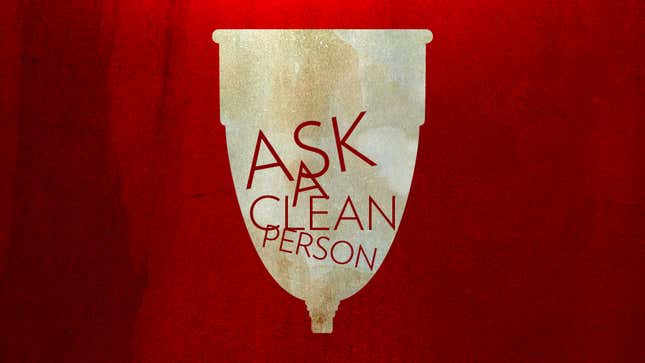Help! How Do I Get Rid Of Blood Stains?
Latest

Jolie Kerr is a cleaning expert and advice columnist. She’ll be here every other week helping to answer your filthiest questions. Are you dirty? Email her.
How would you suggest washing a menstrual cup? I wash it with soap and boil it between uses, but it’s gone all discolored (yellow/brown) and gross looking. Is there anything I can do?
To be perfectly blunt: No, not really.
Menstrual cups are kinda like Silpats in that they are highly likely to discolor fairly early on in your relationship with them. Delivering that news bums me out, and I wish that the people who make those products could maybe address their staining problems? But also: I’m entirely convinced that they could address their staining problems and choose not to because people will replace perfectly-functional-but-stained items which means those companies make more money. My inner Rage Beast is smashing things in protest and then cleaning those things up.
We’ve been together long enough now that I think you’re familiar with my Bad News/Good News paradigm, so without further ado here’s the good news: even if it’s discolored, that menstrual cup will work just fine.
And, in more good news, this question gives me the perfect excuse to go through your basic menstrual cup washing instructions, which are as follows: Wash that cup with a mild soap and water. Alternatively, boil it for 5-10 minutes. The water should be at a good rolling boil, and once you put the cup in the pot it’s important NOT to use a lid. You might want to use the lid to help the water come up to a boil faster though, that’s totally fine.
So! Pretty simple stuff. And while I have your attention, here is a list of things you should absolutely not ever under any circumstances use to clean your menstrual cups, per the manufacturers of said cups:
- Vinegar
- Bleach
- Hydrogen peroxide
- Rubbing alcohol
- Antibacterial soap
- Hand sanitizer
- Moistened wipes
- Tea tree oil
- Oil-based soaps (castile, lavender, peppermint, etc.)
They sure do have a lot of rules, those menstrual cup people. Humph. I’m sure that some of you have cleaned your cups with one or another of those things and not really had too many problems, but it is my sworn duty to tell you these sorts of Official Things.
Speaking of Official Things: The DivaCup website has incredibly detailed instructions on the proper care and keeping of menstrual cups that you could check out if you wanted to learn even more. They also offer a product called DivaWash that may be the ticket to preventing discoloration in the first place. That’s, however, a pretty iffy ‘may’ on my part — I’m generally suspicious of these kinds of super-niche products because there’s usually another multi-use product out there that works just as well and is less expensive.
I was wondering if you know any tricks to get blood out of nylons? It’s not what you think! I didn’t realize I had nicked my ankle shaving until several hours after the fact, and now there is a medium sized scab and some blood stains in what is otherwise a very good pair of hose that I’m not too keen to part with … I’m worried I might rip the material if I try to peel off the scab, and I have no idea what to do about the blood stains. Please help?
Help is here! Nylons are actually pretty easy to clean, oddly enough because they’re so delicate. The first thing you always want to do when you’ve got a pair of stained nylons is to hold the soiled area taut under running water. More often than not, the force of the running water will push that stain right out, or at least partially out. The efficacy of this method does, of course, differ depending on the type of stain — I’m sure in the coming months we’ll talk more extensively about hosiery care, but as a general rule running water is a surprisingly great bet when it comes to getting your pantyhose clean. In terms of that stuck-on scab, the water is going to soften up the combo of dried blood and skin that it’s comprised of and it will essentially disintegrate. It will likely, however, leave behind a bit of a stain which can be treated with a small amount of liquid laundry detergent, hand soap or dish soap.
-

-

-

-

-

-

-

-

-

-

-

-

-

-

-

-

-

-

-

-

-

-

-

-

-

-

-

-

-

-

-

-

-

-

-

-

-

-

-

-








































